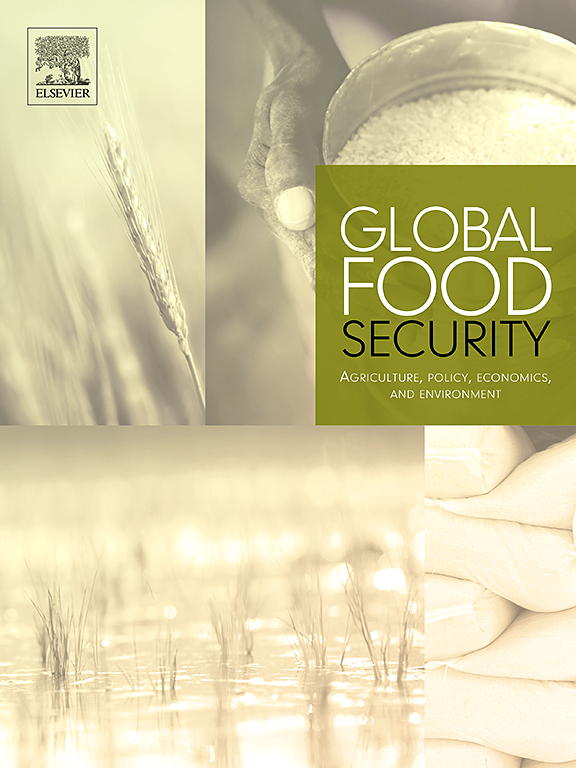界定和衡量粮食系统转型的政策一致性:范围审查
IF 9.6
1区 经济学
Q1 FOOD SCIENCE & TECHNOLOGY
Global Food Security-Agriculture Policy Economics and Environment
Pub Date : 2024-10-25
DOI:10.1016/j.gfs.2024.100803
引用次数: 0
摘要
要实现许多可持续发展目标(SDGs)以及其他全球环境和健康目标,就必须在多个部门和各级政府中改变粮食系统。引导粮食系统取得共同成果,确保一个领域的行动不会破坏另一个领域的进展,这需要政策的一致性。本范围综述研究了如何在与粮食系统转型相关的领域对政策一致性进行广泛定义和衡量,以便为粮食系统转型的具体概念化、定义和衡量提供信息,并为政策和计划的实施提供启示。我们查阅了 2000 年 1 月至 2022 年 12 月期间发表的文献,确定了 47 项符合纳入标准的研究。结果表明,与粮食系统相关的政策一致性定义的共同特点是:强调最小化权衡和最大化协同;政府和粮食系统不同领域内或跨尺度的政策整合(横向或纵向一致性);特定政策领域内目标、干预措施和指标的一致性;粮食系统内部或跨部门行动和目标的互补性和一致性。迄今为止,衡量方法主要局限于定性政策文件审查和参与式评估,没有大规模应用的实例。本文为政策协调性的定义和衡量方法迈出了第一步,可填补监测粮食系统转型治理方面的这一重要数据空白,并综合证据,指导在治理国家粮食系统方面加强政策协调性的行动。本文章由计算机程序翻译,如有差异,请以英文原文为准。
Defining and measuring policy coherence for food system transformation: A scoping review
Changes in food systems—across multiple sectors and through all levels of government—are essential for meeting many of the Sustainable Development Goals (SDGs) and other global environmental and health targets. Steering food systems towards common outcomes and ensuring that actions in one area do not undermine progress in another requires policy coherence. This scoping review examines how policy coherence has been broadly defined and measured in areas related to food system transformation to inform conceptualization, definition, and measurement specific to food systems transformation and provide insights for policy and program implementation. We reviewed literature published from January 2000 to December 2022 and identified 47 studies meeting the inclusion criteria. Results show that common features of definitions of policy coherence relevant for food systems are: an emphasis on minimizing tradeoffs and maximizing synergies; policy integration within different areas of government and food systems or across scales (horizontal or vertical coherence); alignment of objectives, interventions, and indicators within a given policy area; and complementarity and consistency of actions and goals within or across sectors of food systems. Measurement methods to date are mainly limited to qualitative policy document review and participatory assessment, with no examples of application at scale. This paper provides a first step towards a definition and measurement approach for policy coherence that can fill this important data gap in monitoring the governance of food systems transformation and synthesizes evidence to guide actions towards greater policy coherence in governing national food systems.
求助全文
通过发布文献求助,成功后即可免费获取论文全文。
去求助
来源期刊

Global Food Security-Agriculture Policy Economics and Environment
FOOD SCIENCE & TECHNOLOGY-
CiteScore
20.90
自引率
3.40%
发文量
69
期刊介绍:
Global Food Security plays a vital role in addressing food security challenges from local to global levels. To secure food systems, it emphasizes multifaceted actions considering technological, biophysical, institutional, economic, social, and political factors. The goal is to foster food systems that meet nutritional needs, preserve the environment, support livelihoods, tackle climate change, and diminish inequalities. This journal serves as a platform for researchers, policymakers, and practitioners to access and engage with recent, diverse research and perspectives on achieving sustainable food security globally. It aspires to be an internationally recognized resource presenting cutting-edge insights in an accessible manner to a broad audience.
 求助内容:
求助内容: 应助结果提醒方式:
应助结果提醒方式:


